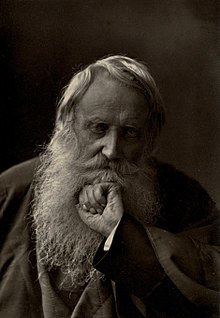Occupation Dramatist and poet Role Dramatist Name Henry Taylor | Nationality British Language English | |
 | ||
Born 18 October 1800Bishop Middleham ( 1800-10-18 ) Spouse Hon. Theodosia Alice Spring Rice Children Five, including Ida Alice Ashworth Taylor Relatives George Taylor (father)Eleanor Ashworth (mother) Died March 27, 1886, Bournemouth, United Kingdom Books The statesman, Edwin the Fair: An Historical Drama, Notes from books | ||
Sir Henry Taylor (18 October 1800 – 27 March 1886) was an English dramatist and poet, official, and well-connected man of letters.
Contents
Early life
Taylor was born on 18 October 1800 in Bishop Middleham, the third son of George Taylor and Eleanor Ashworth. His mother died when he was an infant. His father married Jane Mills in 1818, and the family then moved to Witton-le-Wear.
George Taylor's friend Charles Arbuthnot found positions in London for Henry Taylor and George, one of his older brothers. They went to London in 1817 with the second brother, William, a medical student, but soon afterwards they all caught typhus fever. William and George died in a fortnight. Henry Taylor then took up post in Barbados.
Taylor's place was abolished in 1820, and he returned to his father's house.
At the Colonial Office
Taylor had been introduced to Henry Holland, and through him obtained a clerkship in the Colonial Office. There he worked from 1824 until 1872, serving under the permanent secretary Robert William Hay in particular. He was appointed a Knight Commander of the Order of St Michael and St George (KCMG) in the 1869 Birthday Honours.
Hay's successors were James Stephen, Herman Merivale and Frederic Rogers. Hay, Stephen, Taylor and James Spedding, who also worked in the Office, each brought forward reforming proposals. Taylor and Stephen were allies of Viscount Howick in his abolitionist efforts of the early 1830s. Hay was unhelpful, and was eventually ousted in favour of the efficient Stephen.
Taylor died on 27 March 1886.
Literary connections
Taylor wrote Byronic poems and an article on Thomas Moore, which in 1822 was accepted for the Quarterly Review by William Gifford. Returning to London in October 1823, he found that Gifford had printed another article of his, on Lord John Russell. Taylor had also contributed to the London Magazine, and had an offer of the editorship.
His father George was a friend of William Wordsworth. In 1823, on a visit to the Lake District, Henry Taylor made the acquaintance of Robert Southey, and they became friends. Jane Taylor had a first cousin Isabella Fenwick (1783–1856), and Henry Taylor introduced her to the Wordsworth family. She became a close friend of Wordsworth in later life, as she had been of Taylor up to the time of his marriage.
Taylor's work also brought him literary friends: the circle of Thomas Hyde Villiers, and his colleague James Stephen. He also knew John Sterling. Through Villiers he became acquainted with Charles Austin, John Stuart Mill, and some of the Benthamites. He made speeches in opposition to their views, in the debating society documented by Mill. He also invited them to personal meetings with Wordsworth and Southey. Mill introduced Taylor to Thomas Carlyle in November 1831, initiating a long friendship. Carlyle's opinion of the "marked veracity" of Taylor was printed wrongly by the editor James Anthony Froude as "morbid vivacity".
Taylor aspired to become the official biographer of Southey. The family row over Southey's second marriage, to Caroline Anne Bowles, found him with the Wordsworths and others hostile to Bowles. He did become Southey's literary executor.
Works
In Witton, Taylor wrote The Cave of Ceada which was accepted for the Quarterly Review. Taylor wrote a number of plays, including Isaac Comnenus (1827), and Philip van Artevelde (1834). This latter brought him fame and elicited comparisons with Shakespeare. In 1845 there followed a book of lyrical poems. His essay The Statesman (1836) caused some controversy, as a "supposedly" satirical view of how the civil service worked.
Taylor published his Autobiography in 1885, which contains portraits of Wordsworth, Southey, Tennyson and Walter Scott. In it, on his own account, he gave Richard Whately's opinion of him as a "resuscitated Bacon", who had better things to do than write verse (which could be left to women).
His poem Edwin the Fair depicted Charles Elliot as Earl Athulf. Thomas Frederick Elliot, Charles's brother, was a Colonial Office colleague.
Literary reputation
In his own time, Taylor was highly esteemed as a poet and dramatist. For example, J.G. Lockhart claimed that Philip Van Artevelde secured Taylor "a place among the real artists of his time", and, as late as 1868, J.H. Stirling ranked Philip higher than anything produced by Robert Browning.
Modern literary historians, however, tend to overlook Taylor's accomplishments in verse and drama and emphasize his importance as a literary critic, pointing out that he was a strong advocate for stylistic simplicity, subject matter rooted in common life, and intellectual discipline in poetic composition, placing special importance on clear and reasoned structure.
Family
Taylor married Hon. Theodosia Alice Spring Rice, daughter of Thomas Spring Rice, 1st Baron Monteagle of Brandon, on 17 October 1839. They had five children, including the biographer Ida Alice Ashworth Taylor.
